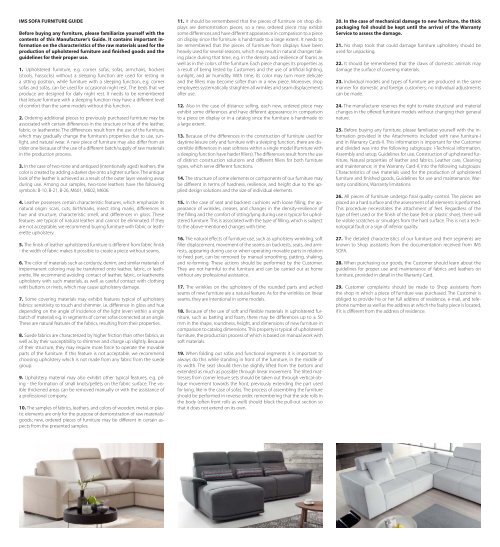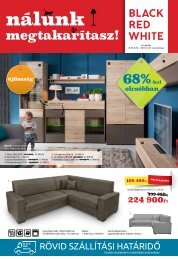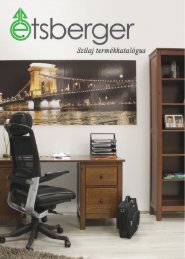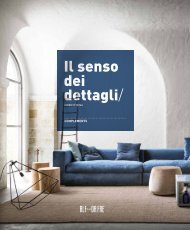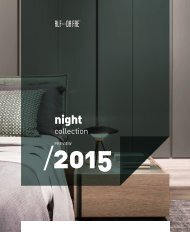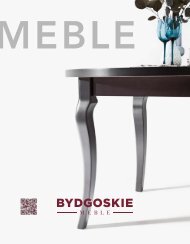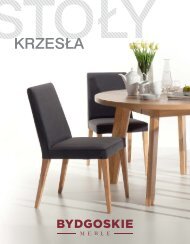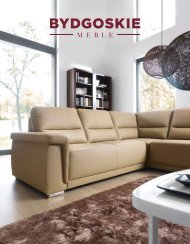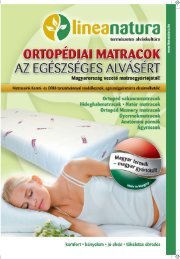Create successful ePaper yourself
Turn your PDF publications into a flip-book with our unique Google optimized e-Paper software.
IMS <strong>SOFA</strong> FURNITURE GUIDE<br />
Before buying any furniture, please familiarize yourself with the<br />
contents of this Manufacturer’s Guide. It contains important information<br />
on the characteristics of the raw materials used for the<br />
production of upholstered furniture and finished goods and the<br />
guidelines for their proper use.<br />
1. Upholstered furniture, e.g. corner sofas, sofas, armchairs, hockers<br />
(stools, hassocks) without a sleeping function are used for resting in<br />
a sitting position, while furniture with a sleeping function, e.g. corner<br />
sofas and sofas, can be used for occasional night rest. The beds that we<br />
produce are designed for daily night rest. It needs to be remembered<br />
that leisure furniture with a sleeping function may have a different level<br />
of comfort than the same models without this function.<br />
2. Ordering additional pieces to previously purchased furniture may be<br />
associated with certain differences in the structure or hue of the leather,<br />
fabric, or leatherette. The differences result from the use of the furniture,<br />
which may gradually change the furniture’s properties due to use, sunlight,<br />
and natural wear. A new piece of furniture may also differ from an<br />
older one because of the use of a different batch/supply of raw materials<br />
in the production process.<br />
3. In the case of two-tone and antiqued (intentionally aged) leathers, the<br />
color is created by adding a darker dye onto a lighter surface. The antique<br />
look of the leather is achieved as a result of the outer layer wearing away<br />
during use. Among our samples, two-tone leathers have the following<br />
symbols: B-10, B-21, B-26, M601, M602, M606.<br />
4. Leather possesses certain characteristic features, which emphasize its<br />
natural origin: scars, cuts, birthmarks, insect sting marks, differences in<br />
hue and structure, characteristic smell, and differences in gloss. These<br />
features are typical of natural leather and cannot be eliminated. If they<br />
are not acceptable, we recommend buying furniture with fabric or leatherette<br />
upholstery.<br />
5. The finish of leather upholstered furniture is different from fabric finish<br />
- the width of fabric makes it possible to create a piece without seams.<br />
6. The color of materials such as corduroy, denim, and similar materials of<br />
impermanent coloring may be transferred onto leather, fabric, or leatherette.<br />
We recommend avoiding contact of leather, fabric, or leatherette<br />
upholstery with such materials, as well as careful contact with clothing<br />
with buttons or rivets, which may cause upholstery damage.<br />
7. Some covering materials may exhibit features typical of upholstery<br />
fabrics: sensitivity to touch and shimmer, i.e. difference in gloss and hue<br />
depending on the angle of incidence of the light (even within a single<br />
batch of material) e.g. in segments of corner sofas connected at an angle.<br />
These are natural features of the fabrics, resulting from their properties.<br />
8. Suede fabrics are characterized by higher friction than other fabrics, as<br />
well as by their susceptibility to shimmer and charge up slightly. Because<br />
of their structure, they may require more force to operate the movable<br />
parts of the furniture. If this feature is not acceptable, we recommend<br />
choosing upholstery which is not made from any fabric from the suede<br />
group.<br />
9. Upholstery material may also exhibit other typical features, e.g. piling<br />
- the formation of small knots/pellets on the fabric surface. The visible<br />
thickened areas can be removed manually or with the assistance of<br />
a professional company.<br />
10. The samples of fabrics, leathers, and colors of wooden, metal, or plastic<br />
elements are only for the purpose of demonstration of raw materials/<br />
goods; new, ordered pieces of furniture may be different in certain aspects<br />
from the presented samples.<br />
11. It should be remembered that the pieces of furniture on shop displays<br />
are demonstration pieces, so a new, ordered piece may exhibit<br />
some differences and have different appearance in comparison to a piece<br />
on display since the furniture is handmade to a large extent. It needs to<br />
be remembered that the pieces of furniture from displays have been<br />
heavily used for several seasons, which may result in natural changes taking<br />
place during that time, e.g. in the density and resilience of foams as<br />
well as in the colors of the furniture. Each piece changes its properties as<br />
a result of being tested by Customers and the use of artificial lighting,<br />
sunlight, and air humidity. With time, its color may turn more delicate<br />
and the fillers may become softer than in a new piece. Moreover, shop<br />
employees systematically straighten all wrinkles and seam displacements<br />
after use.<br />
12. Also in the case of distance selling, each new, ordered piece may<br />
exhibit some differences and have different appearance in comparison<br />
to a piece on display or in a catalog since the furniture is handmade to<br />
a large extent.<br />
13. Because of the differences in the construction of furniture used for<br />
daytime leisure only and furniture with a sleeping function, there are discernible<br />
differences in seat softness within a single model (furniture with<br />
a sleeping function have harder fillers). The differences result from the use<br />
of distinct construction solutions and different fillers for both furniture<br />
types, which serve different functions.<br />
14. The structure of some elements or components of our furniture may<br />
be different in terms of hardness, resilience, and height due to the applied<br />
design solutions and the size of individual elements.<br />
15. In the case of seat and backrest cushions with loose filling, the appearance<br />
of wrinkles, creases, and changes in the density-resilience of<br />
the filling and the comfort of sitting/lying during use is typical for upholstered<br />
furniture. This is associated with the type of filling, which is subject<br />
to the above-mentioned changes with time.<br />
16. The natural effects of furniture use, such as upholstery wrinkling, soft<br />
filler displacement, movement of the seams on backrests, seats, and armrests,<br />
appearing during use or when operating movable parts in relation<br />
to fixed part, can be removed by manual smoothing, patting, shaking,<br />
and re-forming. These actions should be performed by the Customer.<br />
They are not harmful to the furniture and can be carried out at home<br />
without any professional assistance.<br />
17. The wrinkles on the upholstery of the rounded parts and arched<br />
seams of new furniture are a natural feature. As for the wrinkles on linear<br />
seams, they are intentional in some models.<br />
18. Because of the use of soft and flexible materials in upholstered furniture,<br />
such as batting and foam, there may be differences up to ± 50<br />
mm in the shape, roundness, height, and dimensions of new furniture in<br />
comparison to catalog dimensions. This property is typical of upholstered<br />
furniture, the production process of which is based on manual work with<br />
soft materials.<br />
19. When folding out sofas and functional segments it is important to<br />
always do this while standing in front of the furniture, in the middle of<br />
its width. The seat should then be slightly lifted from the bottom and<br />
extended as much as possible through linear movement. The tilted mattresses<br />
from corner leisure sets should be taken out through vertical-oblique<br />
movement towards the front, previously extending the part used<br />
for lying, like in the case of sofas. The process of assembling the furniture<br />
should be performed in reverse order, remembering that the side rolls in<br />
the body (often front rolls as well) should block the pull-out section so<br />
that it does not extend on its own.<br />
20. In the case of mechanical damage to new furniture, the thick<br />
packaging foil should be kept until the arrival of the Warranty<br />
Service to assess the damage.<br />
21. No sharp tools that could damage furniture upholstery should be<br />
used for unpacking.<br />
22. It should be remembered that the claws of domestic animals may<br />
damage the surface of covering materials.<br />
23. Individual models and types of furniture are produced in the same<br />
manner for domestic and foreign customers; no individual adjustments<br />
can be made.<br />
24. The manufacturer reserves the right to make structural and material<br />
changes in the offered furniture models without changing their general<br />
nature.<br />
25. Before buying any furniture, please familiarize yourself with the information<br />
provided in the Attachments included with new furniture-I<br />
and in Warranty Cards-II. This information is important for the Customer<br />
and divided was into the following subgroups: I-Technical information,<br />
Assembly and setup, Guidelines for use, Construction of upholstered furniture,<br />
Natural properties of leather and fabrics, Leather care, Cleaning<br />
and maintenance; in the Warranty Card-II, into the following subgroups:<br />
Characteristics of raw materials used for the production of upholstered<br />
furniture and finished goods, Guidelines for use and maintenance, Warranty<br />
conditions, Warranty limitations.<br />
26. All pieces of furniture undergo final quality control. The pieces are<br />
placed an a hard surface and the assessment of all elements is performed.<br />
This procedure necessitates the attachment of feet. Regardless of the<br />
type of feet used or the finish of the base (felt or plastic shoe), there will<br />
be visible scratches or smudges from the hard surface. This is not a technological<br />
fault or a sign of inferior quality.<br />
27. The detailed characteristics of our furniture and their segments are<br />
known to Shop assistants from the documentation received from IMS<br />
<strong>SOFA</strong>.<br />
28. When purchasing our goods, the Customer should learn about the<br />
guidelines for proper use and maintenance of fabrics and leathers on<br />
furniture, provided in detail in the Warranty Card.<br />
29. Customer complaints should be made to Shop assistants from<br />
the shop in which a piece of furniture was purchased. The Customer is<br />
obliged to provide his or her full address of residence, e-mail, and telephone<br />
number as well as the address at which the faulty piece is located,<br />
if it is different from the address of residence.<br />
<strong>ETAP</strong> <strong>SOFA</strong> 113


